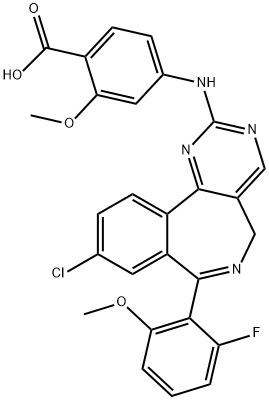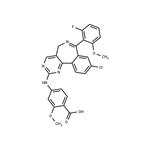Alisertib (MLN8237) is a selective Aurora A inhibitor with IC50 of 1.2 nM in a cell-free assay. It has >200-fold higher selectivity for Aurora A than Aurora B. Phase 3.
MLN8237 shows >200-fold higher selectivity for Aurora A than the structurally related Aurora B with an IC50 of 396.5 nM, and does not have any significant activity against 205 other kinases. [1] MLN8237 (0.5 μM) treatment inhibits the phosphorylation of Aurora A in MM1.S and OPM1 cells, without affecting the Aurora B mediated histone H3 phosphorylation. MLN8237 significantly inhibits cell proliferation in multiple myeloma (MM) cell lines with IC50 values of 0.003-1.71 μM. MLN8237 displays more potent anti-proliferation activity against primary MM cells and MM cell lines in the presence of BM stroma cells, as well as IL-6 and IGF-1 than against MM cells alone. MLN8237 (0.5 μM) induces 2- to 6-fold increase in G2/M phase in primary MM cells and cell lines, as well as significant apoptosis and senescence, involving the up-regulation of p53, p21 and p27, as well as PARP, caspase 3, and caspase 9 cleavage. In addition, MLN8237 shows strong synergistic anti-MM effect with dexamethasone, as well as additive effect with doxorubicin and bortezomib.MLN8237 (0.5 μM) treatment causes the inhibition of colony formation of FLO-1, OE19, and OE33 esophageal adenocarinoma cell lines, and induces a significant increase in the percentage of polyploid cells, and subsequently an increase in the percentage of cells in the sub-G1 phase, which can be further enhanced in combination with cisplatin (2.5 μM), involving the higher induction of TAp73β, PUMA, NOXA, cleaved caspase-3, and cleaved PARP as compared with a single-agent treatment.
MLN8237 significantly reduces the tumor burden with tumor growth inhibition (TGI) of 42% and 80% at 15 mg/kg and 30 mg/kg, respectively, and prolongs the survival of mice compared with the control.
Alisertib (MLN8237, 1028486-01-2) is a highly selective and potent (IC50?= 1 nM) cell permeable inhibitor of Aurora A with off-target binding at GABAA?(IC50?= 490 nM).1?It disrupts the Aurora A-Myc complex leading to Myc degradation2?in Myc amplified neuroblastomas3?and p53-mutant human hepatocellular carcinoma cell4. Alisertib has been found to induce apoptosis and autophagy in breast cancer5?and melanoma6?cells?via?suppression of activation of the p38 MAPK pathway.
An Aurora kinase inhibitor, used to treat patients with advanced solid tumors.
ChEBI: 4-[[9-chloro-7-(2-fluoro-6-methoxyphenyl)-5H-pyrimido[5,4-d][2]benzazepin-2-yl]amino]-2-methoxybenzoic acid is a benzazepine.
1) Sells?et al.?(2015),?MLN8054 and Alisertib (MLN8237):Discovery of Selective Oral Aurora A Inhibitors; ACS Med. Chem. Lett.?6?630
2) Richards?et al.?(2016),?Structural basis of N-Myc binding by Aurora-A and its destabilization by kinase inhibitors; Proc. Natl. Acad. Sci. USA?113?13726
3) Brockmann?et al.?(2013),?Small molecule inhibitors of aurora-a induce proteasomal degradation of N-myc in childhood neuroblastoma; Cancer Cell?24?75
4) Dauch?et al.?(2016),?A MYC-aurora kinase A protein complex represents an actionable drug target in p53-altered liver cancer; Nat. Med.?22?744
5) Li?et al.?(2015),?The investigational Aurora kinase A inhibitor alisertib (MLN8237) induces cell cycle G2/M arrest, apoptosis, and autophagy via p38 MAPK and Akt/mTOR signaling pathways in human breast cancer cells; Drug Des. Devel. Ther.?16?1627
6) Shang?et al.?(2017),?Alisertib promotes apoptosis and autophagy in melanoma through p38 MAPK-mediated aurora a signaling; Oncotarget?8?107076



